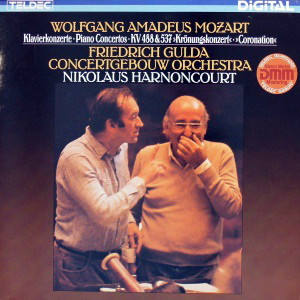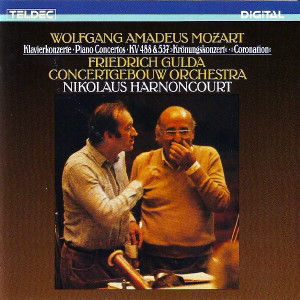 |
1 LP -
6.42970 AZ - (p) 1984
|
 |
| 1 CD -
8.42970 ZK - (p) 1984 |
|
| Wolfgang
Amadeus Mozart (1756-1791) |
|
|
|
|
|
|
|
Konzert für Klavier und
Orchester Nr. 26 D-dur, KV 537
("Krönungskonzert")
|
|
32' 58" |
|
- Allegro
|
15' 14" |
|
A1 |
- (Larghetto)
|
6' 28" |
|
A2 |
| - (Allegretto) |
11' 16" |
|
A3 |
Konzert
für Klavier und Orchester Nr. 23 A-dur,
KV 488
|
|
25' 58" |
|
- Allegro
|
11' 38" |
|
B1 |
| - Adagio |
6' 24" |
|
B2 |
| - Allegro assai |
7' 56" |
|
B3 |
|
|
|
|
| Friedrich
Gulda, Klavier |
|
|
|
| CONCERTGEBOUW
ORCHESTRA, AMSTERDAM |
|
| Nikolaus
Harnoncourt, Dirigent |
|
|
Luogo
e data di registrazione
|
| Concertgebouw,
Amsterdam (Olanda) - settembre 1983 |
|
Registrazione
live / studio
|
| studio |
Producer
/ Engineer
|
-
|
Prima Edizione CD
|
| Teldec
- 8.42970 ZK - (1 cd) - 59' 16" - (p)
1984 - DDD |
Prima
Edizione LP
|
Teldec - 6.42970
AZ - (1 lp) - 59'
16"
- (p) 1984 -
Digital
|
|
|
Notes
|
The two Piano
Concertos K. 488 in A major and the
late “Coronation”
concerto K. 537 are
well-known not only to the Mozart-lover.
The A major work, composed in March
l768 for one of the Academy concerts
during Lent, is much prized for its
elegant, yet never superficial
conversation tone, and a certain
lyrical-galant air; the listener is
unsettled by the F sharp minor adagio,
which sounds to some like an
anticipation of l9th century Venice
and its intoxication with death. It is
scarcely possible to imagine a greater
contrast with this intimacy, which
comes close to chamber music, than the
imposing mannerisms of the D major
concerto, which Mozart played in
Frankfurt during the festivities
surrounding the coronation of Emperor
Leopold II in October l790. It became
the favourite child of the
l9th century because it fitted so wcll
into the image of Mozart commonly held
in that period - and indeed in others;
one could enthuse so wholeheartedly,
yet just a little condescendingly,
about its unclouded festive character,
its relaxed virtuosity and the
“abundance of ideas so generously
scattered about” (Friedrich
Blume). Everyone, in other words,
knows these works - or thinks he does.
No-one will be surprised that this
belief begins to waver a
little when Gulda and
Harnoncourt take up the two concerti
and produce their own versions of
them. And, although this may not to be
the place to prejudge a productionßs
success or failure, it can only be of
advantage to pass the microphone to a
musician as articulate as Harnoncourt
and let him support some of the
unusual features of this
interpretation. “I am tired of hearing
time after time that I
"brush Mozart up the wrong
way", he says. “I take
him at his word. The piano is
prescribed as a continuo instrument
throughout in all Mozart concerti. The
pianist should not come in like a
great star, as in a 19th century
virtuoso concerto: he should be
present from the beginning,
disengaging himself
then from the orchestra and being
‘left over` on his own, so to speak.
This "joining
in" in the orchestral
tuttis is of course, essential as it
is, extrernely difficult.
What is the pianist supposed to play,
how is this `piano continuo` to be
integrated into the orchestra without
sounding like Rachmaninov?
Well, with Gulda`s brilliance all this
was no longer a problem.”
Gulda is almost always
present, providing for a dry, springy
rhythm in the bass, and sometimes,as
in the first movement
of the “Coronation” concerto (e. g.
bar 59), he colours the overall sound
with arpeggios. Transparency, however,
retains the upper hand; not least
owing to Harnoncourt`s
frequent allocation of the
accompanying string parts to soloists.
exactly as Mozart specified
- this results in a concertino being
split off from the
tutti. This helps the pianist,
protects the music from decaying al
fresco, and moreover was perfectly
normal practice in the composer’s
lifetirne, as Harnoncourt
knows. This detail of performance
practice has already been taken into
consideration in the New Mozart
Edition.
Yet their mutual enlightenment never
tempts Gulda,
Harnoncourt or the orchestra into
having a small group of player
followed schematically by a larger
one, or into granting stylistic purism
pride of place over music-making. They
leave the A major work
its nobility and ennoble the
“Coronation” concerto, bringing it
close to Mozart’s great
D major works, disciplining its festive
splendour by substantial counterpoint
as in the “Haffner”
or “Prague” symphonies or the “Don
Giovanni” overture. There can be no
doubt about it: all the participants
involved in this recording see Mozart
as a radical.
Werner
Burkhardt
Translation: Clive R. Williams
|
|
Nikolaus
Harnoncourt (1929-2016)
|

|

|
|